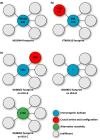The long and winding road towards epitope matching in clinical transplantation
- PMID: 30341790
- PMCID: PMC7379527
- DOI: 10.1111/tri.13362
The long and winding road towards epitope matching in clinical transplantation
Abstract
Recent data suggest that HLA epitope matching is beneficial for the prevention of de novo donor specific antibody (DSA) formation after transplantation. In this review, different approaches to predict the immunogenicity of an HLA mismatch will be discussed. The parameters used in these models are often called epitopes but the actual antibody epitope is far more complex. Exact knowledge of the antibody epitope is crucial if epitope matching is also used as a tool to select compatible donors for (highly) sensitized patients. Evidence is provided that it is not always possible to give an exact definition of an antibody epitope. We conclude that HLA "epitope" matching is superior over HLA antigen matching with respect to the prevention of de novo DSA formation and will enhance the prediction of acceptable HLA mismatches for sensitized patients. However, epitope matching at our current level of knowledge will not solve all histocompatibility problems as unexpected antibody reactivity still may occur.
Keywords: HLA matching; antibodies; epitopes; immunogenicity; virtual crossmatch.
© 2018 The Authors. Transplant International published by John Wiley & Sons Ltd on behalf of Steunstichting ESOT.
Conflict of interest statement
The authors have declared no conflicts of interest.
Figures



Similar articles
-
Anti-HLA Antibody: The Role of Epitopes in Organ Transplantation.Exp Clin Transplant. 2019 Jan;17(Suppl 1):38-42. doi: 10.6002/ect.MESOT2018.L41. Exp Clin Transplant. 2019. PMID: 30777521 Review.
-
Defining the immunogenicity and antigenicity of HLA epitopes is crucial for optimal epitope matching in clinical renal transplantation.HLA. 2017 Jul;90(1):5-16. doi: 10.1111/tan.13038. Epub 2017 Apr 5. HLA. 2017. PMID: 28378521 Review.
-
Critical evaluation of a possible role of HLA epitope matching in kidney transplantation.Transplant Rev (Orlando). 2020 Apr;34(2):100533. doi: 10.1016/j.trre.2020.100533. Epub 2020 Jan 17. Transplant Rev (Orlando). 2020. PMID: 32007300 Review.
-
Novel aspects of epitope matching and practical application in kidney transplantation.Kidney Int. 2018 Feb;93(2):314-324. doi: 10.1016/j.kint.2017.08.008. Epub 2017 Oct 20. Kidney Int. 2018. PMID: 29061333 Review.
-
Towards the identification of the relative immunogenicity of individual HLA antibody epitopes.Hum Immunol. 2019 Apr;80(4):218-220. doi: 10.1016/j.humimm.2019.02.002. Epub 2019 Feb 5. Hum Immunol. 2019. PMID: 30735757
Cited by
-
Computational Eurotransplant kidney allocation simulations demonstrate the feasibility and benefit of T-cell epitope matching.PLoS Comput Biol. 2021 Jul 27;17(7):e1009248. doi: 10.1371/journal.pcbi.1009248. eCollection 2021 Jul. PLoS Comput Biol. 2021. PMID: 34314431 Free PMC article.
-
Defining the structural basis for human leukocyte antigen reactivity in clinical transplantation.Sci Rep. 2020 Oct 27;10(1):18397. doi: 10.1038/s41598-020-75355-4. Sci Rep. 2020. PMID: 33110123 Free PMC article.
-
Patterns of 1,748 Unique Human Alloimmune Responses Seen by Simple Machine Learning Algorithms.Front Immunol. 2020 Jul 28;11:1667. doi: 10.3389/fimmu.2020.01667. eCollection 2020. Front Immunol. 2020. PMID: 32849576 Free PMC article.
-
Development of an immunogenicity score for HLA-DQ eplets: A conceptual study.HLA. 2021 Jan;97(1):30-43. doi: 10.1111/tan.14110. Epub 2020 Oct 28. HLA. 2021. PMID: 33068062 Free PMC article.
-
Donor-Specific Antibodies Targeting a Repeated Eplet Mismatch and Outcome After Kidney Retransplantation.Transpl Int. 2024 Nov 29;37:13639. doi: 10.3389/ti.2024.13639. eCollection 2024. Transpl Int. 2024. PMID: 39679067 Free PMC article.
References
-
- Dausset J, Brecy H. Identical nature of the leucocyte antigens detectable in monozygotic twins by means of immune iso‐leuco‐agglutinins. Nature 1957; 180: 1430. - PubMed
-
- Van Rood JJ, Eernisse JG, Van Leeuwen A. Leucocyte antibodies in sera from pregnant women. Nature 1958; 181: 1735. - PubMed
-
- Van Rood JJ, Van Leeuwen A, Eernisse JG, Frederiks E, Bosch LJ. Relationship of leukocyte groups to tissue transplantation compatibility. Ann N Y Acad Sci 1964; 120: 285. - PubMed
-
- van Rood JJ. A proposal for international cooperation in organ transplantation: eurotransplant In: Curtoni ES, Mattiuz PL, Tosi RM, eds. Histocompatibility Testing. Baltimore, MD: Williams and Wilkins, 1967: 451.
Publication types
MeSH terms
Substances
LinkOut - more resources
Full Text Sources
Other Literature Sources
Research Materials

